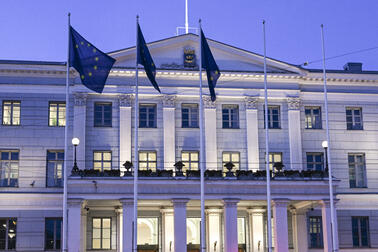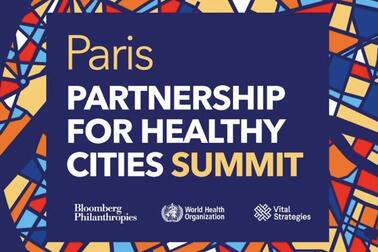
Helsinki's safety and security issues are solved in cooperation between the city, the authorities and organisations, but the city is responsible for managing the big picture. This ensures that the information does not become fragmented.
Safety work as a concept includes responding to new phenomena, maintaining and repairing infrastructure, plenty of social work and anticipating serious threats but also solving smaller problems. When cities are concerned, local residents are always at the heart of safety planning.
In Helsinki, the Safety and Preparedness Unit is in charge of safety as a whole collaborating with the city's divisions and enterprises.
"Cooperation is the key word in all our activities, and it is essential that we have good networks. That is why we also employ a police coordinator on a leave of absence from the police," tells Katariina Kainulainen-D'Ambrosio, the acting chief of preparedness.
"Our task is to stay up-to-date on the phenomena that surface in different areas and to coordinate the safety planning carried out widely in the urban environment. We also prepare for various incidents, from a mere power cut to a state of emergency. We aim to be prepared for almost anything," explains Kainulainen-D'Ambrosio.
Because the work is done for the benefit of people, the availability of the city's staff members is important particularly in regional changes. The ideas of the city's residents are heard, and the aim is to involve them in the decision-making.
"It is also important to provide the residents with a direct contact to the city's employees when changes are planned in their area. A direct line of communication running both ways is important, and trust improves the feeling of safety," Kainulainen-D'Ambrosio explains the city's approach.
"With regards to bigger phenomena or major concerns, we participate in networks in which different parties work to solve large entities. Here at the Safety and Preparedness Unit, we maintain the overall vision of safety.”
Maintaining safety demands long-term work
Helsinki residents' experience of safety is measured every three years, and it has been steadily growing. Currently locals are concerned in particular about social problems, such as substance abuse, young people's wellbeing and traffic safety.
"We are pleased to see that young people in general do not appear to have experienced an increase in safety-related problems; the issue is that those young people who were vulnerable already before the pandemic are experiencing further hardship now. It is an issue that is taken very seriously in Helsinki," explains Kainulainen-D'Ambrosio, the acting chief of preparedness.
"The same issue concerns the homeless as well because many of the day centres have remained closed during the coronavirus outbreak. Thus, the city has invested in outreach work, in other words, those usually working in youth clubs have taken to the streets.”
The Safety and Preparedness Unit approaches issues from many different angles according to Kainulainen-D'Ambrosio.
"As an example, the feeling of safety is often exactly that, a feeling. For some, seeing a police patrol on the streets may increase their feeling of safety whilst for others, it is a sign of something being wrong."
According to Kainulainen-D'Ambrosio, supporting the residents' feeling of safety is largely about the way in which the urban environment is looked after and maintained.
"For instance, if street lighting is out of order for a long time, the notion is that no one is looking after things, and that alone creates insecurity. However, the most important thing in a city is to solve root causes. Maintaining safety in a city is long-term work, which is never complete.”
Katariina Kainulainen-D'Ambrosio, the chief of preparedness at the City of Helsinki, coordinates the city's safety work.
Problems in residential areas to be solved with urban residents in mind
The Safety and Preparedness Unit used to also take a more active role in regional work and participated in solving problems. Now the unit keeps up-to-date with phenomena through its networks, and a large group of people and actors attend to the situations that come up. The community worker Soile Atacocugu works in the Social Services and Health Care Division.
The community worker Soile Atacocugu solves regional problems in her work.
"It is hard to define my job description exactly. My area of responsibility in Helsinki is the northern area, and I aim to know the residential organisations, locals and other regional actors and any worries and phenomena they bring to my attention," Atacocugu summarises.
A good example of her work is her response to the concerns regarding the activities in the surroundings of the Maunula House.
"One local contacted me and told that as the pubs had disappeared with the closure of the shopping centre, a group of people had been left without a place to hang out. Many of them meet one another daily outside the Maunula House and near-by. Some of the locals feel that the substance abusers are a cause for worry for them, for example, when they wish to use the bank machine," Atacocugu describes a fairly common situation.
The work of a community worker is largely about being familiar with the networks, but it is also important to be able to see the situation in the area with the eyes of the locals.
"In the case of Maunula, I started by getting to know the area on foot; I talked to people involved with outreach work and a local inhabitant and considered which other operators there are near Maunula House. I walked into the nearest church to have a chat with the church social worker. Next, I contacted the social worker at the Oulunkylä Parish and the outreach instructor for substance abuse," she tells.
"We have gathered together a team of local actors who are able to participate in solving the situation. One solution was to start offering breakfast once a week, utilising Helsinki's food aid project, in local premises and offering a food recovery bag to those in attendance. That provided an opportunity to establish a contact with local substance abuse employees and other parties offering various activities. If services can be improved, the situation naturally calms down a bit and the feeling of safety increases. This could lay the groundwork for a full-time day centre or other such service organised by maybe an organisation, if it becomes evident that the area would benefit from the introduction of low-threshold services," Atacocugu sums up.
Atacocugu thinks it is important to remember one thing when talking about solutions for urban spaces.
"All inhabitants, also those who cause disruption, are local residents and everyone has the right to occupy urban spaces. The situation cannot be solved by sweeping the disruption under a rug; we need to think about the issue in depth and find a solution that works best for all parties.”
Iframe not supported
The article is part of the Nordic Safe Cities alliance's Safe City Tour. Nordic Safe Cities(Link leads to external service) (NSC), established by the Nordic Council of Ministers in 2016, is a non-profit network focusing on safety in the Nordic countries. The NSC activities aim to have a positive impact on safety in cities and to stand against polarisation and violent extremism. Helsinki has participated in the network's activities from the start.
Text: Vilja Roihu / Stooritaivas Oy
Images: Aki Rahikka / Stooritaivas Oy


